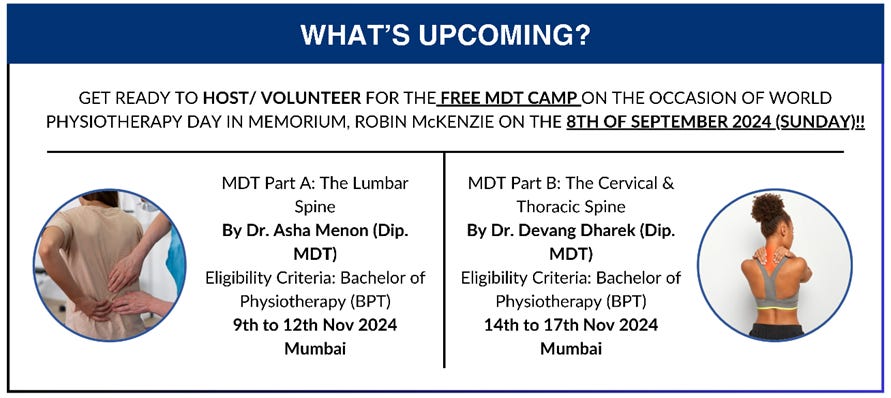What makes the McKenzie Method of Mechanical Diagnosis and Therapy/ MDT unique? | Case Study - Thumb pain responding to Cervical Spine movements.
MDT Connect | Volume 1, Issue 1 | June 2024
FROM THE EXECUTIVE DIRECTOR’S DESK…
“WHAT MAKES THE McKENZIE METHOD OF MECHANICAL DIAGNOSIS AND THERAPY/ MDT UNIQUE?
- By Dr Sonali Mehta, Dip MDT
Image credit: storyset.com
MDT is not merely a technique/ procedure limited to its application to spinal conditions, rather it is a classification system with a structured framework of musculoskeletal assessment that encompasses the assessment and management of both Spinal and Extremity conditions.
MDT is a well researched management approach for MS disorders. Evidence-based care globally being applied by skilled clinicians across 30 countries with India being one of them.
The MDT classification system consists of 4 categories, namely the Derangement, Dysfunction and Postural syndromes and the subgroups of OTHER. Each category has specific criteria which enables the clinician to identify and understand which clinical presentations fits within each. Management is determined by the classification which enables the clinician to provide management strategies appropriate for individual patients.
The MDT assessment screens the underlying cause of symptoms rather than solely relying on pathoanatomical site of symptoms. As MDT doesn't rely purely on pathoanatomical consideration, it utilizes the patients symptomatic, mechanical, functionally limited activities, as a baseline measure across which the change is studied. Repeated movement testing being the essence of the McKenzie assessment, reliance on expensive imaging/scans is reduced to a considerable amount.
The McKenzie method utilizes the BIOPSYCHOSOCIAL model consisting of the Drivers of pain and disability, looking at pain from the multidimensional perspective. This structure helps clinicians to identify and manage the barriers to recovery providing a targeted multimodal care.
The assessment and the use of the progression of forces for management provide a safety built-in mechanism ensuring the clinician knows when it is safe to put their hands on and when off. A structured history taking and the response to either repeated movement testing/ sustained positioning enables the desired shielded pathway. This also ensures that patient forces are sufficient enough to manage their own aches and pains, promoting self-management.
A good structured assessment provides clarity about the condition, avoids confusion of diagnosis amongst other clinicians due to standardization of operational terms and definition providing targeted treatment reflecting into better outcomes.
An MDT clinician is able to provide an appropriate education about the overall condition adding to the therapeutic alliance and encouraging self-management.
Nutshell:
References:
1. Rosedale R, Rastogi R, Kidd J, Lynch G, Supp G, Robbins SM. A study exploring the prevalence of Extremity Pain of Spinal Source (EXPOSS). J Man Manip Ther. 2020;28(4):222-230. doi:10.1080/10669817.2019.1661706.
Click here to find the full text of the above research article!
2. Tousignant-Laflamme Y, Cook CE, Mathieu A, et al. Operationalization of the new Pain and Disability Drivers Management model: A modified Delphi survey of multidisciplinary pain management experts. J Eval Clin Pract. 2020;26(1):316-325. doi:10.1111/jep.13190
Click here to find the abstract of the above research article!
CASE STUDY - THUMB PAIN RESPONDING TO CERVICAL SPINE MOVEMENTS.
- By Dr Kanchan Palsule, Cert. MDT
Clinical reasoning:
Pain location of B/L forearm pain (along with left thumb pain), nil movement loss of the wrist and 1st CMC joint, presence of movement loss at the cervical spine indicated towards examining the spinal repeated movements to determine if the symptoms are arising from the cervical spine.
Spinal testing was relevant in this case on Day 1 of the evaluation and a classification of spinal derangement was confirmed on the subsequent sessions and managed accordingly.
Bottom line: It is crucial to take important clues from the history and examination that guides the clinician with accurate classification and appropriate education and management.
*Please click here to fill and submit the MDT Newsletter Feedback form*










